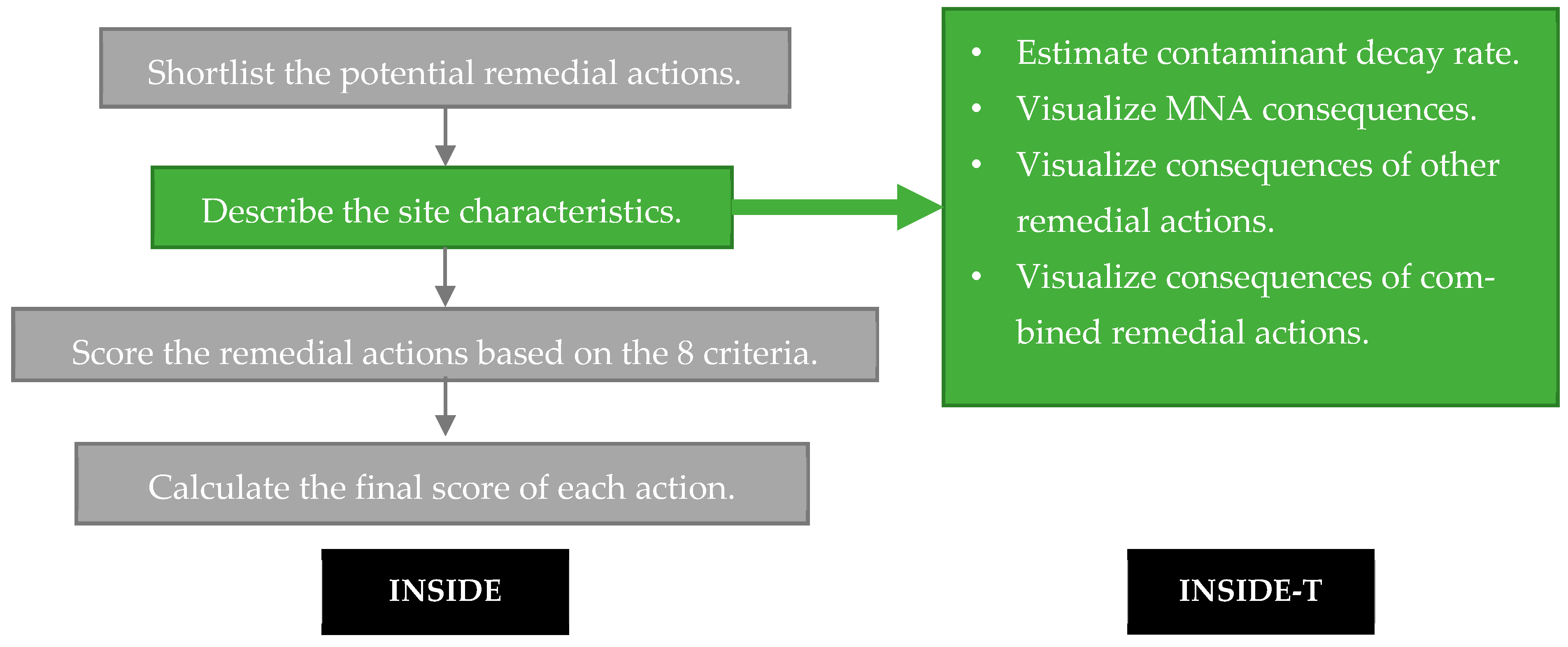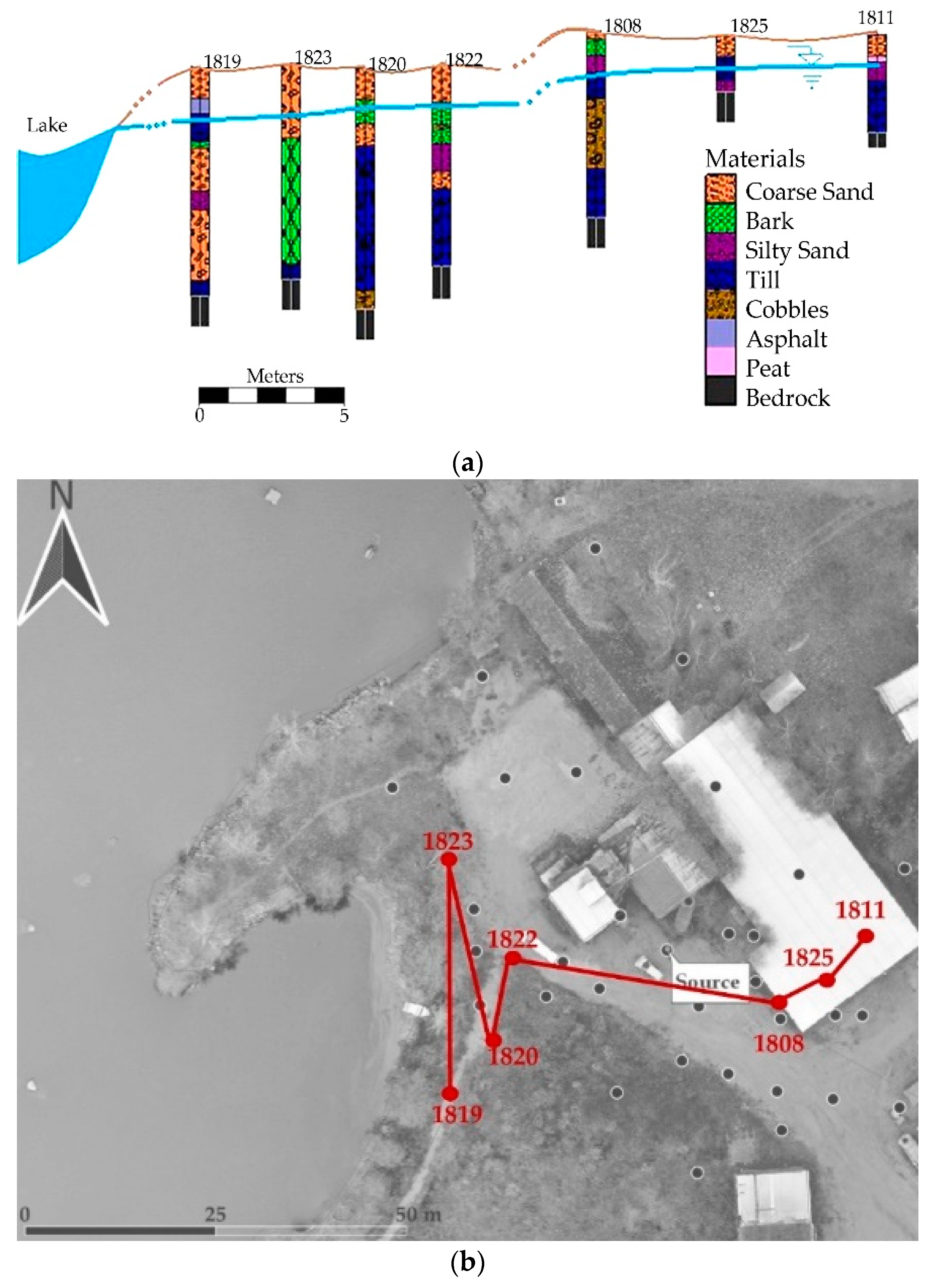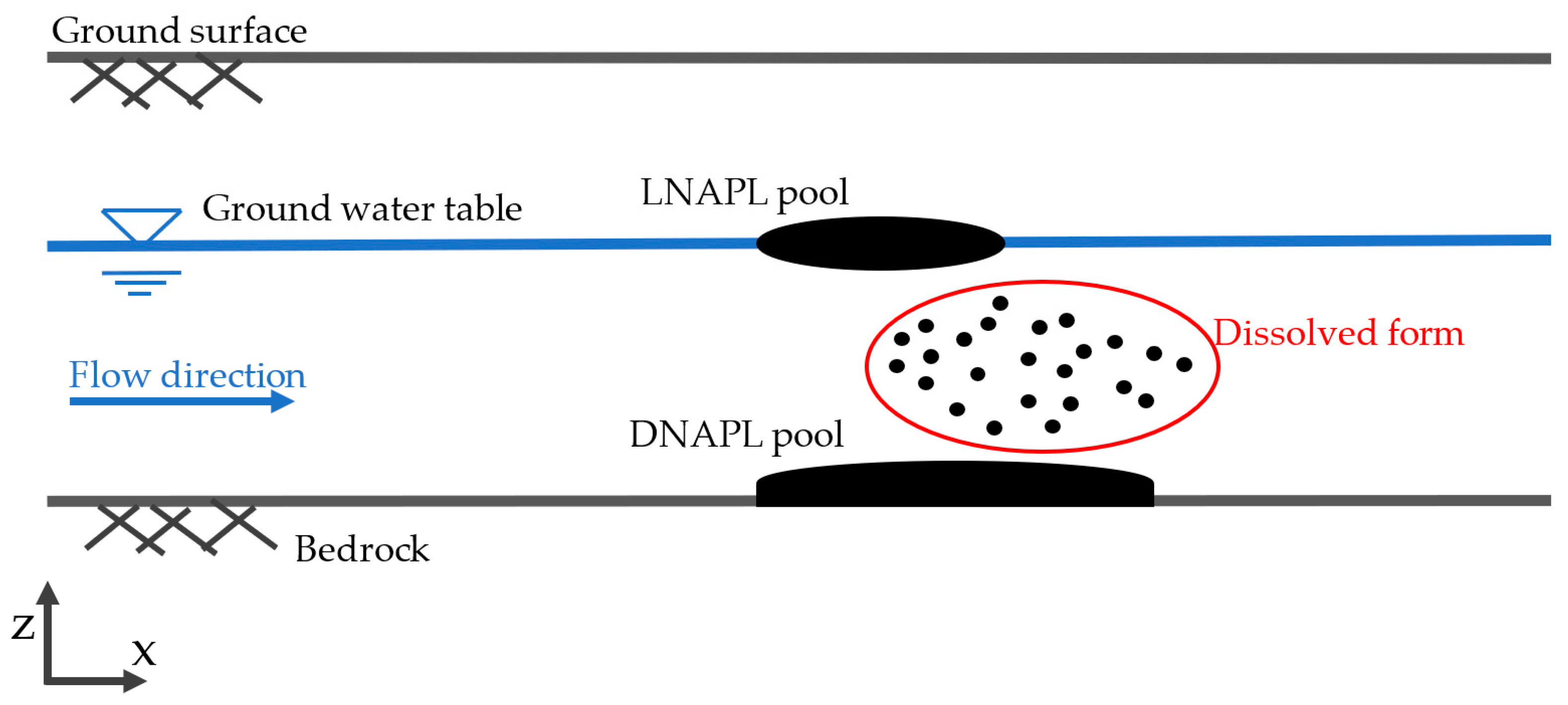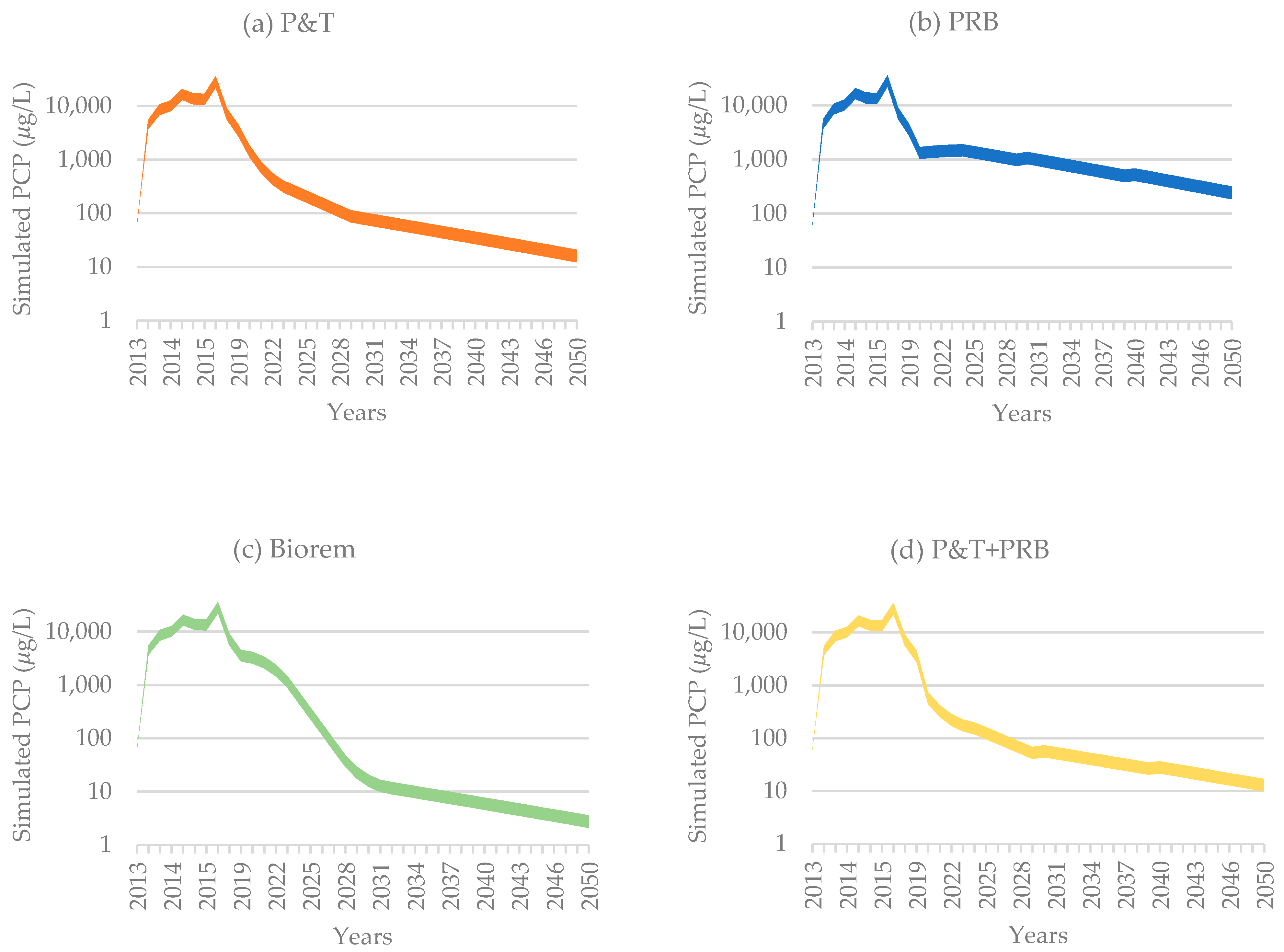INSIDE-T: A Groundwater Contamination Transport Model for Sustainability Assessment in Remediation Practice
Abstract
:1. Introduction
2. Materials and Methods
2.1. Outline of Process and Steps
2.2. Contaminant Decay Rate Calculation
2.2.1. Concentration Trend Analysis by Mann–Kendall Test
2.2.2. Calculating Contaminant Decay Rate through Mass Flux
2.3. Contaminant Transport and Fate Modeling
2.4. Case Study
2.4.1. Geologic Media
2.4.2. Contaminant Characteristics
3. Results
3.1. Implementing the Model
3.2. Assessing MNA as a Remedial Option
3.3. Assessing Alternative Remedial Scenarios
4. Discussion
5. Conclusions
- MNA is not a viable option for the site in terms of the accepted remediation timeframe;
- a combination of P&T with PRB would be almost as effective as bioremediation, assuming five years after implementation as the cut-off point for the simulated concentration reduction at the recipient; and
- these insights can help site managers in developing and selecting sustainable remediation strategies.
Supplementary Materials
Author Contributions
Funding
Data Availability Statement
Acknowledgments
Conflicts of Interest
Model Availability
References
- Hou, D.; Li, F. Complexities Surrounding China’s Soil Action Plan. Land Degrad. Dev. 2017, 28, 2315–2320. [Google Scholar] [CrossRef] [Green Version]
- Suthersan, S.S.; Horst, J.; Schnobrich, M.; Welty, N.; McDonough, J. Remediation Engineering, Design Concepts, 2nd ed.; CRC Press, Taylor & Francis Group: Boca Raton, FL, USA, 2017. [Google Scholar]
- Palma, V.; Accorsi, F.; Casasso, A.; Bianco, C.; Cutrì, S.; Robiglio, M.; Tosco, T. AdRem: An Integrated Approach for Adaptive Remediation. Sustainability 2021, 13, 28. [Google Scholar] [CrossRef]
- Maskooni, E.K.; Naseri-rad, M.; Berndtsson, R.; Nakagawa, K. Use of Heavy Metal Content and Modified Water Quality Index to Assess Groundwater Quality in a Semiarid Area. Water 2020, 12, 1115. [Google Scholar] [CrossRef] [Green Version]
- Chowdhury, S.; Kain, J.-H.; Adelfio, M.; Volchko, Y.; Norrman, J. Greening the Browns: A Bio-Based Land Use Framework for Analysing the Potential of Urban Brownfields in an Urban Circular Economy. Sustainability 2020, 12, 6278. [Google Scholar] [CrossRef]
- Lemming, G.; Chambon, J.C.; Binning, P.J.; Bjerg, P.L. Is there an environmental bene fi t from remediation of a contaminated site? Combined assessments of the risk reduction and life cycle impact of remediation. J. Environ. Manag. 2012, 112, 392–403. [Google Scholar] [CrossRef]
- Norrman, J.; Söderqvist, T.; Volchko, Y.; Back, P.; Bohgard, D.; Ringshagen, E.; Svensson, H.; Englöv, P.; Rosén, L. Enriching social and economic aspects in sustainability assessments of remediation strategies—Methods and implementation. Sci. Total Environ. 2020, 707, 136021. [Google Scholar] [CrossRef]
- Swedish EPA. Lägesbeskrivning av Efterbehandlingsarbetet i Landet (Situation Description of the Decontamination Work in the Country); Swedish EPA: Stockholm, Sweden, 2008.
- Swedish EPA. Lägesbeskrivning av Arbetet Med Efterbehandling av Förorenade Områden (Situation Description of the Work with Decontamination of Contaminated Areas). Available online: https://www.naturvardsverket.se/upload/sa-mar-miljon/mark/fororenade-omraden/lagesbeskrivning-20170413.pdf (accessed on 18 October 2020).
- Forslund, J.; Samakovlis, E.; Johansson, M.V.; Barregard, L. Does remediation save lives?—On the cost of cleaning up arsenic-contaminated sites in Sweden. Sci. Total Environ. 2010, 408, 3085–3091. [Google Scholar] [CrossRef] [Green Version]
- Vredin Johansson, M.; Forslund, J.; Johansson, P.; Samakovlis, E. Can we buy time? Evaluation of the Swedish government’s grant to remediation of contaminated sites. J. Environ. Manag. 2011, 92, 1303–1313. [Google Scholar] [CrossRef]
- McKnight, U.S.; Finkel, M. A system dynamics model for the screening-level long-term assessment of human health risks at contaminated sites. Environ. Model. Softw. 2013, 40, 35–50. [Google Scholar] [CrossRef]
- Marcomini, A.; Suter, W.G., II; Critto, A. Decision Support Systems for Risk-Based Management of Contaminated Sites; Springer Science & Business Media, LLC: Berlin/Heidelberg, Germany, 2009; ISBN 9780387097213. [Google Scholar]
- Bardos, R.P.; Bakker, L.M.M.; Slenders, H.L.A.; Nathanail, C.P. Sustainability and Remediation BT—Dealing with Contaminated Sites: From Theory towards Practical Application; Swartjes, F.A., Ed.; Springer: Dordrecht, The Netherlands, 2011; pp. 889–948. ISBN 978-90-481-9757-6. [Google Scholar]
- Funk, S.P.; Hnatyshin, D.; Alessi, D.S. HYDROSCAPE: A new versatile software program for evaluating contaminant transport in groundwater. SoftwareX 2017, 6, 261–266. [Google Scholar] [CrossRef]
- McKnight, U.S.; Funder, S.G.; Rasmussen, J.J.; Finkel, M.; Binning, P.J.; Bjerg, P.L. An integrated model for assessing the risk of TCE groundwater contamination to human receptors and surface water ecosystems. Ecol. Eng. 2010, 36, 1126–1137. [Google Scholar] [CrossRef] [Green Version]
- Locatelli, L.; Binning, P.J.; Sanchez-vila, X.; Lemming, G.; Rosenberg, L.; Bjerg, P.L. A simple contaminant fate and transport modelling tool for management and risk assessment of groundwater pollution from contaminated sites. J. Contam. Hydrol. 2019, 221, 35–49. [Google Scholar] [CrossRef] [PubMed]
- Zheng, C.; Bennett, G.D. Applied Contaminant Transport Modeling, 2nd ed.; Wiley-Interscience: New York, NY, USA, 2002; Volume 2. [Google Scholar]
- Harclerode, M.A.; Macbeth, T.W.; Miller, M.E.; Gurr, C.J.; Myers, T.S. Early decision framework for integrating sustainable risk management for complex remediation sites: Drivers, barriers, and performance metrics. J. Environ. Manag. 2016, 184, 57–66. [Google Scholar] [CrossRef] [PubMed]
- Ogata, A.; Banks, R.B. A Solution of the Differential Equation of Longitudinal Dispersion in Porous Media; US Government Printing Office: Washington, DC, USA, 1961.
- Ogata, A. Theory of Dispersion in a Granular Medium; US Government Printing Office: Washington, DC, USA, 1970.
- Wexler, E.J. Analytical Solutions for One-, Two-, and Three-Dimensional Solute Transport in Ground-Water Systems with Uniform Flow; US Government Printing Office: Washington, DC, USA, 1992.
- Bauer, P.; Attinger, S.; Kinzelbach, W. Transport of a decay chain in homogenous porous media: Analytical solutions. J. Contam. Hydrol. 2001, 49, 217–239. [Google Scholar] [CrossRef]
- Sudicky, E.A.; Hwang, H.-T.; Illman, W.A.; Wu, Y.-S.; Kool, J.B.; Huyakorn, P. A semi-analytical solution for simulating contaminant transport subject to chain-decay reactions. J. Contam. Hydrol. 2013, 144, 20–45. [Google Scholar] [CrossRef]
- Paladino, O.; Moranda, A.; Massabò, M.; Robbins, G.A. Analytical Solutions of Three-Dimensional Contaminant Transport Models with Exponential Source Decay. Groundwater 2018, 56, 96–108. [Google Scholar] [CrossRef]
- Newell, C.J.; McLeod, R.K.; Gonzales, J.R. BIOSCREEN, Natural Attenuation Decision Support System; Version 1.4; United States Environmental Protection Agency, Office of Research and Development: Washington, DC, USA, 1997.
- Aziz, C.E.; Newell, C.J.; Gonzales, J.R. BIOCHLOR, Natural Attenuation Decision Support System; Version 2.2; United States Environmental Protection Agency, Office of Research and Development: Washington, DC, USA, 2002.
- Falta, R.W.; Ahsanuzzaman, A.N.M.; Stacy, M.B.; Earle, R.C. REMFuel, Remediation Evaluation Model for Fuel Hydrocarbons; Version 1.0; United States Environmental Protection Agency, Office of Research and Development: Washington, DC, USA, 2012.
- Falta, R.W.; Stacy, M.B.; Ahsanuzzaman, A.N.M. REMChlor, Remediation Evaluation Model for Chlorinated Solvents; Version 1.0; United States Environmental Protection Agency, Office of Research and Development: Washington, DC, USA, 2007.
- Naseri-Rad, M.; Berndtsson, R.; Persson, K.M.; Nakagawa, K. INSIDE: An efficient guide for sustainable remediation practice in addressing contaminated soil and groundwater. Sci. Total Environ. 2020, 740, 139879. [Google Scholar] [CrossRef]
- Gabus, A.; Fontela, E. World Problems an Invitation to Further Thought within the Framework of DEMATEL; Batelle Institute, Geneva Research Center: Geneva, Switzerland, 1972. [Google Scholar]
- Saaty, T.L. Decision Making with Dependence and Feedback: The Analytic Network Process; RWS Publications: Pittsburgh, PA, USA, 1996. [Google Scholar]
- Fetter, C.W.; Boving, T.; Kreamer, D. Contaminant Hydrogeology, 3rd ed.; Waveland Press, Inc.: Long Grove, IL, USA, 2018; ISBN 9781478632795. [Google Scholar]
- Mann, H.B. Nonparametric Tests against Trend. Econometrica 1945, 13, 245–259. [Google Scholar] [CrossRef]
- Gocic, M.; Trajkovic, S. Analysis of changes in meteorological variables using Mann-Kendall and Sen’s slope estimator statistical tests in Serbia. Glob. Planet. Chang. 2013, 100, 172–182. [Google Scholar] [CrossRef]
- Wang, F.; Shao, W.; Yu, H.; Kan, G.; He, X.; Zhang, D.; Ren, M.; Wang, G. Re-evaluation of the Power of the Mann-Kendall Test for Detecting Monotonic Trends in Hydrometeorological Time Series. Front. Earth Sci. 2020, 8, 14. [Google Scholar] [CrossRef]
- United States Environmental Protection Agency Chapter IX, Monitored Natural Attenuation. In How to Evaluate Alternative Cleanup Technologies for Underground Storage Tank Sites; United States Environmental Protection Agency, Land and Emergency Management: Washington, DC, USA, 2017.
- Avula, X.J.R. Mathematical Modeling. In Encyclopedia of Physical Science and Technology, 3rd ed.; Meyers, R.A., Ed.; Academic Press: New York, NY, USA, 2003; pp. 219–230. ISBN 978-0-12-227410-7. [Google Scholar]
- Freeze, R.A.; Cherry, J.A. Groundwater; Prentice-Hall: Hoboken, NJ, USA, 1979; ISBN 9780133653120. [Google Scholar]
- Bear, J. Dynamics of Fluids in Porous Media; Dover: New York, NY, USA, 1988; ISBN 0486656756. [Google Scholar]
- Van Genuchten, M.T. Analytical solutions for chemical transport with simultaneous adsorption, zero-order production and first-order decay. J. Hydrol. 1981, 49, 213–233. [Google Scholar] [CrossRef]
- Hantush, M.S. Analysis of data from pumping tests in leaky aquifers. Eos, Trans. Am. Geophys. Union 1956, 37, 702–714. [Google Scholar] [CrossRef]
- Li, Z.; Chen, B.; Wu, H.; Ye, X.; Zhang, B. A design of experiment aided stochastic parameterization method for modeling aquifer NAPL contamination. Environ. Model. Softw. 2018, 101, 183–193. [Google Scholar] [CrossRef]
- Swedish EPA. The Role of Pentachlorophenol Treated Wood for Emissions of Dioxins into the Environment. Available online: https://www.naturvardsverket.se/Documents/publikationer/978-91-620-5935-4.pdf?pid=3534 (accessed on 18 October 2020).
- Elander, P.; Eriksson, H. Södra Skogsägarna Hjortsberga f.d. Sågverk Fördjupad Riskbedömning och Åtgärdsutredning (In-Depth risk Assessment and Action Investigation Report for Southern Hjortsberga Former Sawmill). Available online: https://www.lansstyrelsen.se/download/18.76f16c3d1665eba4c3e50bc/1539688734395/Fördjupadriskbedömningochåtgärdsutredning,Envipro2007pdf (accessed on 18 October 2020).
- Nord, H. Provtagningar och Undersökningar av Grundvatten, Sediment, Ytvatten och Dehalococoider (Sampling and Investigations of Groundwater, Sediment, Surface Water and Dehalococoids); RGS Nordic: Stockholm, Sweden, 2019. [Google Scholar]
- Johansson, A. Groundwater Flow Modelling to Address Hydrogeological Response of a Contaminated Site to Remediation Measures at Hjortsberga, Southern Sweden. Bachelor’s Thesis, Lund University, Lund, Sweden, 2020. [Google Scholar]
- Axelsson, P.; Håkansson, K. Hjortsberga såg, Undersökningsrapport Avseende Åtgärdsförberedande Undersökningar (Hjortsberga sawmil, Investigation Report Regarding Action-Preparatory Investigations); LÄNSSTYRELSEN: Stockholm, Sweden, 2012. [Google Scholar]
- Johansson, L. Södra Skogsägarna Ekonomisk Förening. Utökad Undersökning vid Hjortsberga Sågverk (Southern Forest Owners Cooperative Society. Extended Investigation at Hjortsberga Sawmill). Available online: https://www.lansstyrelsen.se/download/18.4e0415ee166afb59324449/1540558355286/S%C3%A5gverkiHjortsberga-Ut%C3%B6kadunders%C3%B6kning,SWECOVIAK2006.pdf (accessed on 18 October 2020).
- Liu, F.; Xu, B.; He, Y.; Brookes, P.C.; Xu, J. Co-transport of phenanthrene and pentachlorophenol by natural soil nanoparticles through saturated sand columns. Environ. Pollut. 2019, 249, 406–413. [Google Scholar] [CrossRef]
- Hurst, C.J.; Sims, C.R.; Sims, L.J.; Sorensen, L.D.; McLean, E.J.; Huling, S. Soil Gas Oxygen Tension and Pentachlorophenol Biodegradation. J. Environ. Eng. 1997, 123, 364–370. [Google Scholar] [CrossRef]
- Schmidt, L.M.; Delfino, J.J.; Preston, J.F., 3rd; St Laurent, G., 3rd. Biodegradation of low aqueous concentration pentachlorophenol (PCP) contaminated groundwater. Chemosphere 1999, 38, 2897–2912. [Google Scholar] [CrossRef]
- Rao, M.A.; Di Rauso Simeone, G.; Scelza, R.; Conte, P. Biochar based remediation of water and soil contaminated by phenanthrene and pentachlorophenol. Chemosphere 2017, 186, 193–201. [Google Scholar] [CrossRef]
- Nash, J.E.; Sutcliffe, J.V. River flow forecasting through conceptual models part I—A discussion of principles. J. Hydrol. 1970, 10, 282–290. [Google Scholar] [CrossRef]
- Moriasi, D.N.; Arnold, J.G.; Van Liew, M.W.; Bingner, R.L.; Harmel, R.D.; Veith, T.L. Model Evaluation Guidelines for Systematic Quantification of Accuracy in Watershed Simulations. Trans. ASABE 2007, 50, 885–900. [Google Scholar] [CrossRef]
- WNR. Guidance on Natural Attenuation for Petroleum Releases; Wisconsin Department of Natural Resources, WNR: Madison, WI, USA, 2014.
- Dekking, F.M.; Kraaikamp, C.; Lopuhaä, H.P.; Meester, L.E. A Modern Introduction to Probability and Statistics: Understanding Why and How; Springer: New York, NY, USA, 2005. [Google Scholar]
- Mackay, D.M.; Cherry, J.A. Groundwater contamination: Pump-and-treat remediation. Environ. Sci. Technol. 1989, 23, 630–636. [Google Scholar] [CrossRef]
- Obiri-Nyarko, F.; Grajales-Mesa, S.J.; Malina, G. An overview of permeable reactive barriers for in situ sustainable groundwater remediation. Chemosphere 2014, 111, 243–259. [Google Scholar] [CrossRef]
- FRTR. Evaluation of Permeable Reactive Barrier Performance; Federal Remediation Technologies Roundtable (FRTR): USA, 2002. Available online: https://frtr.gov/pdf/2-prb_performance.pdf (accessed on 7 July 2021).
- McGuire, T.M.; Adamson, D.T.; Burcham, M.S.; Bedient, P.B.; Newell, C.J. Evaluation of Long-Term Performance and Sustained Treatment at Enhanced Anaerobic Bioremediation Sites. Groundw. Monit. Remediat. 2016, 36, 32–44. [Google Scholar] [CrossRef]
- Loehr, R.C.; Webster, M.T. Performance of long-term, field-scale bioremediation processes. J. Hazard. Mater. 1996, 50, 105–128. [Google Scholar] [CrossRef]
- Guerin, T.F. Long-term performance of a land treatment facility for the bioremediation of non-volatile oily wastes. Resour. Conserv. Recycl. 2000, 28, 105–120. [Google Scholar] [CrossRef]
- Hou, D. Sustainable Remediation of Contaminated Soil and Groundwater: Materials, Processes, and Assessment; Butterworth-Heinemann, An Imprint of Elsevier; Elsevier: Amsterdam, The Netherlands, 2020; ISBN 012817983X. [Google Scholar]
- Rosén, L.; Back, P.-E.; Söderqvist, T.; Norrman, J.; Brinkhoff, P.; Norberg, T.; Volchko, Y.; Norin, M.; Bergknut, M.; Döberl, G. SCORE: A novel multi-criteria decision analysis approach to assessing the sustainability of contaminated land remediation. Sci. Total Environ. 2015, 511, 621–638. [Google Scholar] [CrossRef] [PubMed]
- Li, X.; Li, J.; Sui, H.; He, L.; Cao, X.; Li, Y. Evaluation and determination of soil remediation schemes using a modi fi ed AHP model and its application in a contaminated coking plant. J. Hazard. Mater. 2018, 353, 300–311. [Google Scholar] [CrossRef]
- Hou, D.; Ding, Z.; Li, G.; Wu, L.; Hu, P.; Guo, G.; Wang, X.; Ma, Y.; Connor, D.O.; Wang, X. A sustainability assessment framework for agricultural land remediation in China. Land Degrad. Dev. 2018, 29, 1005–1018. [Google Scholar] [CrossRef]
- Radelyuk, I.; Naseri-Rad, M.; Hashemi, H.; Persson, M.; Berndtsson, R.; Yelubay, M.; Tussupova, K. Assessing data-scarce contaminated groundwater sites surrounding petrochemical industries. Environ. Earth. Sci. 2021, 80, 351. [Google Scholar] [CrossRef]







| Parameter | ne | αL | αT | Koc | foc | ||||
|---|---|---|---|---|---|---|---|---|---|
| Unit | m | m | m/d | - | m | m | kg/L | L/kg | - |
| Initial Estimates | |||||||||
| Taken from | FM | FM * | FM | FM | Lit ** | Lit | FM | Lit | Lit |
| Min | 5 | 3 | 0.04 | 0.25 | 1 | αL/20 | 1.9 | 398 | 0.0002 |
| Max | 65 | 5 | 40 | 0.35 | 30 | αL/6 | 2.4 | 19,953 | 0.02 |
| Simulation Results | |||||||||
| 1st quartile | 9.00 | 3.00 | 4.00 | 0.30 | 26.00 | 2.60 | 2.17 | 398.00 | 0.0034 |
| Median | 9.09 | 3.00 | 4.00 | 0.32 | 27.68 | 2.77 | 2.20 | 398.47 | 0.0103 |
| 3rd quartile | 10.52 | 3.03 | 4.60 | 0.35 | 28.00 | 2.80 | 2.20 | 399.96 | 0.0187 |
| St. dev. | 0.68 | 0.31 | 0.46 | 0.02 | 0.94 | 0.56 | 0.10 | 0.89 | 0.0074 |
Publisher’s Note: MDPI stays neutral with regard to jurisdictional claims in published maps and institutional affiliations. |
© 2021 by the authors. Licensee MDPI, Basel, Switzerland. This article is an open access article distributed under the terms and conditions of the Creative Commons Attribution (CC BY) license (https://creativecommons.org/licenses/by/4.0/).
Share and Cite
Naseri-Rad, M.; Berndtsson, R.; McKnight, U.S.; Persson, M.; Persson, K.M. INSIDE-T: A Groundwater Contamination Transport Model for Sustainability Assessment in Remediation Practice. Sustainability 2021, 13, 7596. https://doi.org/10.3390/su13147596
Naseri-Rad M, Berndtsson R, McKnight US, Persson M, Persson KM. INSIDE-T: A Groundwater Contamination Transport Model for Sustainability Assessment in Remediation Practice. Sustainability. 2021; 13(14):7596. https://doi.org/10.3390/su13147596
Chicago/Turabian StyleNaseri-Rad, Mehran, Ronny Berndtsson, Ursula S. McKnight, Magnus Persson, and Kenneth M. Persson. 2021. "INSIDE-T: A Groundwater Contamination Transport Model for Sustainability Assessment in Remediation Practice" Sustainability 13, no. 14: 7596. https://doi.org/10.3390/su13147596
APA StyleNaseri-Rad, M., Berndtsson, R., McKnight, U. S., Persson, M., & Persson, K. M. (2021). INSIDE-T: A Groundwater Contamination Transport Model for Sustainability Assessment in Remediation Practice. Sustainability, 13(14), 7596. https://doi.org/10.3390/su13147596








